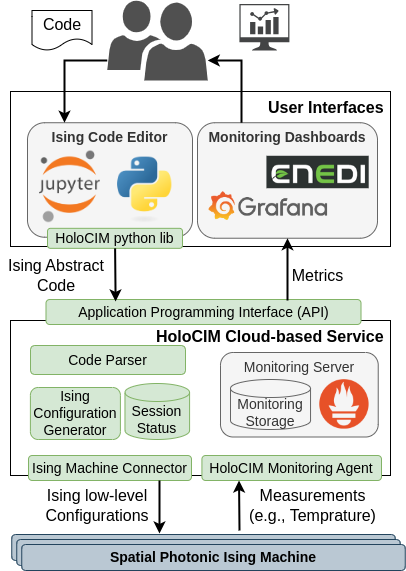Blog post 2. UCY, 26/07/2024
Combinatorial optimization problems present challenges across various domains such as logistics, network design, and decision-making, where finding solutions requires numerous trials. Traditional computers struggle with these, due to their computational complexity. In Computer Science, these problems are known as NP-Complete problems. Typically, heuristics are used to solve these problems, though they often yield suboptimal solutions. An alternative approach involves physical-inspired systems that can efficiently solve specific NP-Complete problems. To use these solvers, the input problem must be mapped into a configuration compatible with the physical system, and the output must then be translated into a useful representation.
To this end, we have implemented the Holocim platform as an end-to-end spatial photonic platform, aiming to solve specific NP-Complete problems in an as-a-service way. Holocim is designed as a multi-layered software platform where at top level it provides a UI for HoloCIM clients, and a production-ready cloud-based platform capable of handling external requests. The platform takes as an input the user’s NP problem and auto-compiles it to an Ising representation that is comprehensible to the underlying Ising machine.

The Holocim’s underlying Ising machine utilises advanced holographic techniques to achieve amplitude and phase modulation. A spatial light modulator (SLM) is employed to control the interactions among the spins, and the spin values by encoding both of them in the optical wavefront. For a given spin configuration and predefined mutual interactions the Ising energy is computed by recording the Fourier transformed SLM image on the camera’s plane. The minimum Ising energy is computed using Metropolis-based algorithms through an optoelectronic iteration scheme, which updates the spin configuration on the SLM at each iteration step.
Additionally, the platform is equipped with web-based APIs for communication at both ends. Currently, the users can make use of the platform to solve their Ising model problems or make use of any of HoloCIM’s pre-designed problems, like number partitioning and bin packing. Furthermore, Holocim provides monitoring capabilities and permission management to the system’s administrators. More details on how to make use of the platform can be found in the video at the end of this blog post.
At this point, we provide screenshots of the platform’s UI, presenting a set of pre-designed problems (bin packing, and number partitioning) to the Holocim platform that are ready to use by the end users in different cases. On top of that, users have the ability to design their own problems based on the existing examples. Lastly, platform admins can manage users and Ising machines as well as monitoring the system usage in real time.



